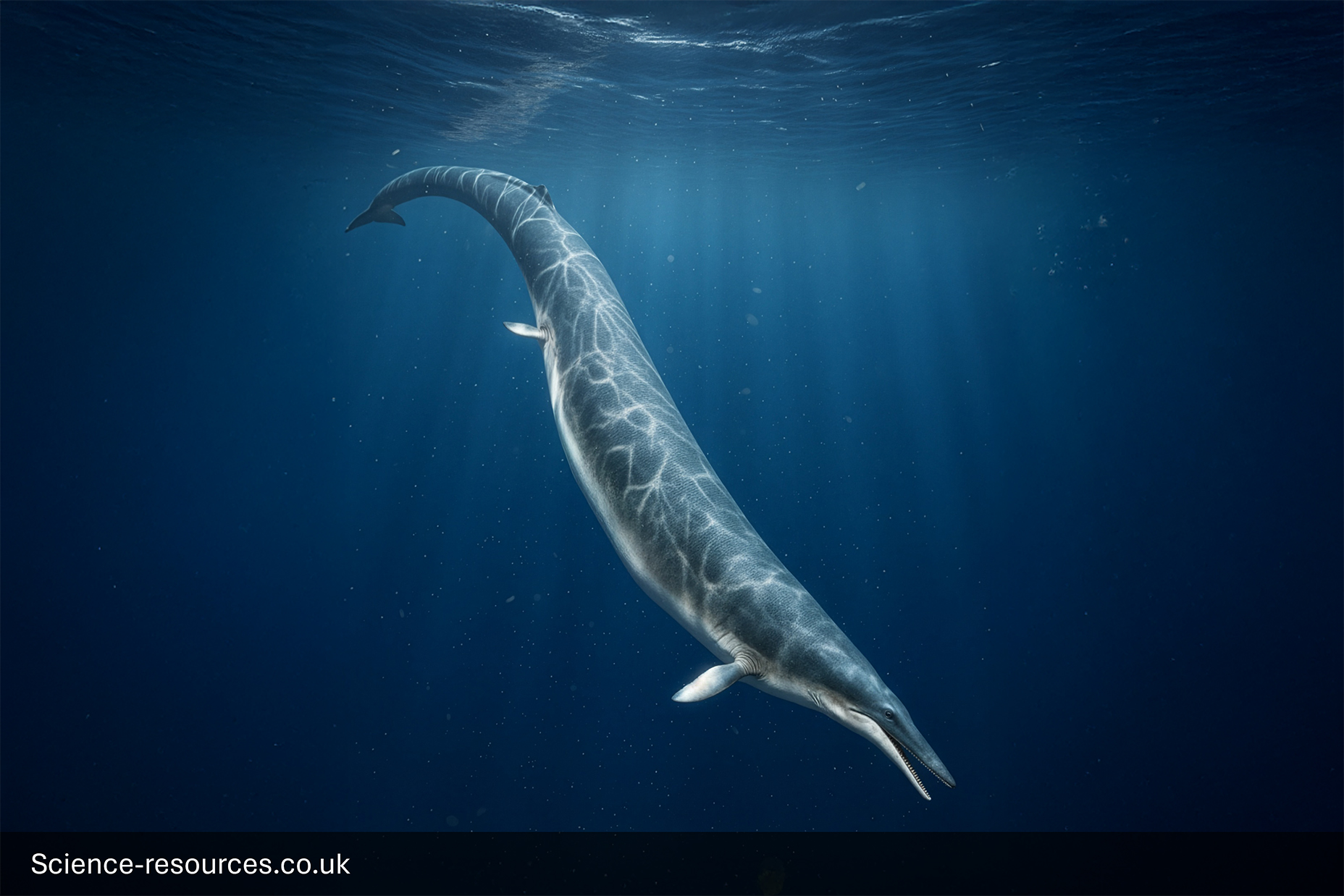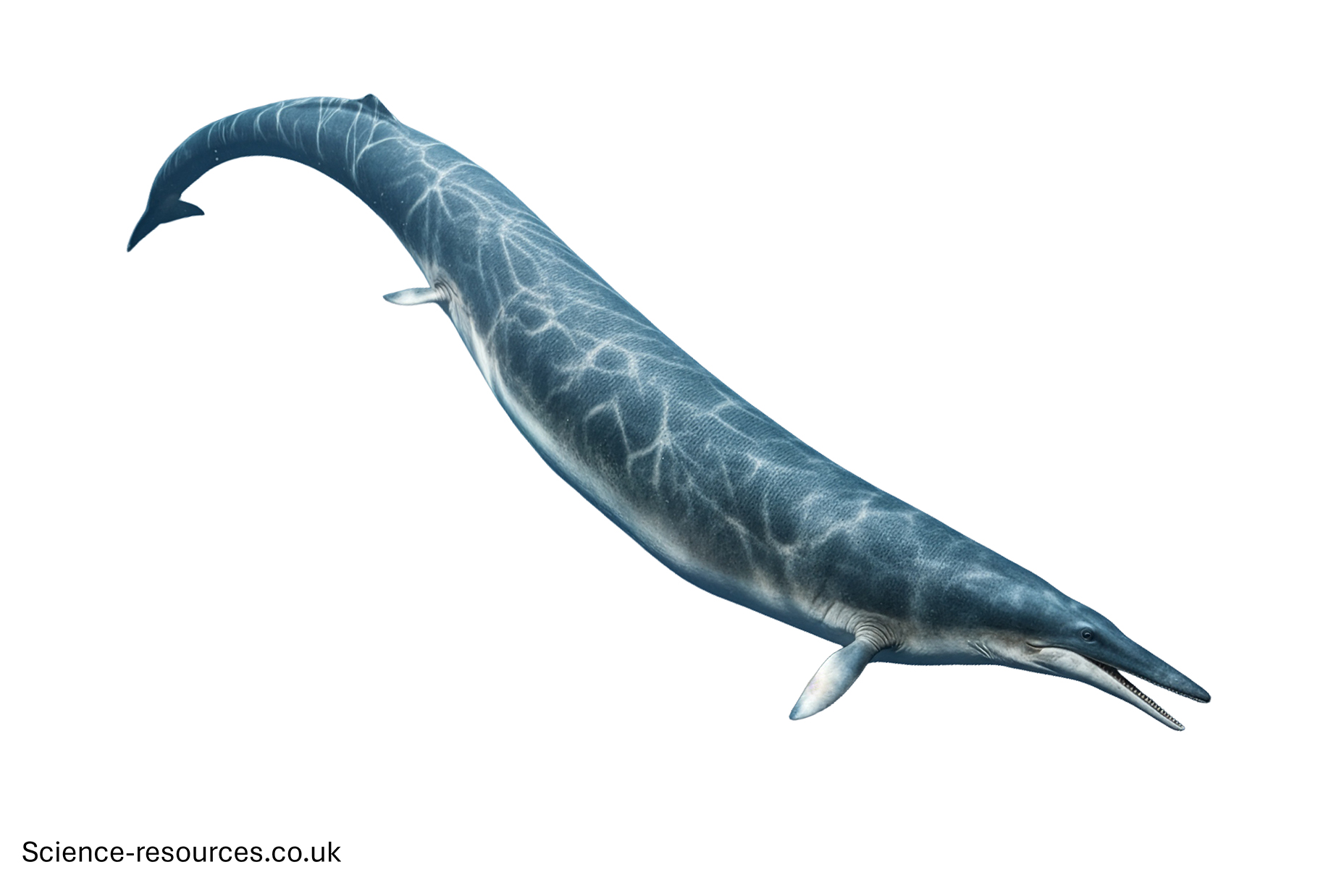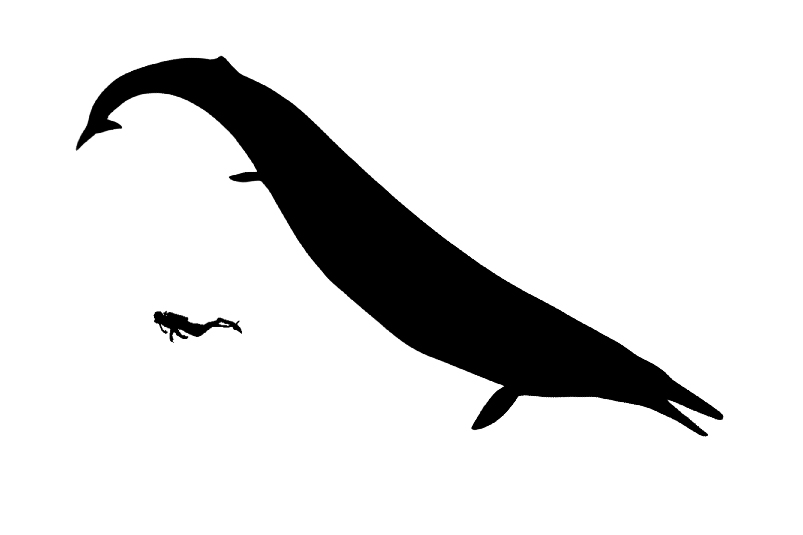Last updated: 4th August 2025
Extinct Animals: Basilosaurus
Basilosaurus, an extinct, prehistoric whale that swam in the world’s oceans millions of years ago.
Basilosaurus (King Lizard)
 Basilosaurus
Basilosaurus
Generative AI Notification: Some elements of this image have been created or enhanced using AI technology. To find out how we create all our prehistoric animals, click here.
What is Basilosaurus?
Basilosaurus was a gigantic prehistoric whale that swam in the world’s oceans millions of years ago. It was one of the first fully aquatic whales and a top predator during its time.
How big was Basilosaurus?
Basilosaurus could grow up to 15–18 metres (49–59 feet) long. It weighed between 10 and 20 tonnes.
What did Basilosaurus eat?
Basilosaurus was a carnivore, preying on fish, sharks, and other marine mammals. Its long, conical teeth were perfect for grasping slippery prey and tearing flesh.
Basilosaurus appearance
Basilosaurus had a long, snake-like body with a small head, sharp teeth, and tiny, useless hind legs. Its body was slender compared to modern whales, making it look more like a sea serpent than today’s whales.
 Basilosaurus appearance
Basilosaurus appearance
Where did Basilosaurus live?
Fossils of Basilosaurus have been found in North America, Northern Africa, and parts of the Middle East. It lived in warm, shallow seas that covered much of these regions during its era.
Interesting facts
- Basilosaurus means "King Lizard" but it’s actually a mammal, not a lizard!
- It was one of the first whales fully adapted to life in the water and could not live on land.
- Basilosaurus had tiny, useless hind legs—leftovers from its land-dwelling ancestors.
- It had a powerful bite and was the top predator in its ecosystem.
- Despite its name, it was not a dinosaur or a reptile.
Basilosaurus Facts
Pronounced: bah-SIL-oh-SAW-rus
Name Means: "King Lizard"
Length: Up to 18 metres (59 feet)
Weight: Up to 20,000 kilograms (20 tonnes)
Diet: Carnivore (meat-eater)
Time: Eocene Epoch (about 41 to 34 million years ago)
Fossils Found: North America, Northern Africa, Middle East
Which family of animals did Basilosaurus belong to?
Basilosaurus belonged to the family Basilosauridae, ancient whales that were the first to live fully in the water. Modern whales, dolphins, and porpoises are distant relatives.
What other animals lived at the same time as Basilosaurus?
Basilosaurus shared its oceans with ancient sharks, early dolphins, sea turtles, and giant marine reptiles during the Eocene epoch.
Basilosaurus FAQ
Q1: What was Basilosaurus?
A1: Basilosaurus is an extinct species of giant whale that lived millions of years ago. It was a top predator in the ancient seas.
Q2: What did Basilosaurus look like?
A2: Basilosaurus had a long, snake-like body, sharp teeth, and tiny back legs that didn’t work. It looked very different from modern whales.
Q3: How big was Basilosaurus?
A3: It could grow up to 18 metres (59 feet) in length and weighed as much as 20 tonnes.
Q4: What did Basilosaurus eat?
A4: Basilosaurus hunted fish, sharks, and other marine mammals.
Q5: Where did Basilosaurus live?
A5: It lived in warm, shallow seas in what is now North America, Africa, and the Middle East.
Q6: When did Basilosaurus go extinct?
A6: Basilosaurus went extinct about 34 million years ago, as the climate changed and new types of whales evolved.
Q7: How strong was Basilosaurus’s bite?
A7: Its bite was powerful enough to crush bone and catch large prey, though not as strong as Megalodon's.
Q8: How is Basilosaurus related to modern animals?
A8: Basilosaurus is an ancient relative of today’s whales, dolphins, and porpoises.
Q9: Who discovered Basilosaurus?
A9: Fossilised bones of Basilosaurus were first discovered in the United States in the early 19th century. Scientists originally thought it was a giant lizard!
Q10: Are there any complete skeletons of Basilosaurus?
A10: Yes, several nearly complete skeletons have been found, including skulls, vertebrae, and even tiny hind limbs!
You may also be intrested in:
- Extinct Animals: A-Z
- Dinosaurs: A-Z
Tags: How big was Basilosaurus, Basilosaurus size, where did Basilosaurus live, how long was Basilosaurus, what does Basilosaurus mean, Basilosaurus facts
Up next: Daeodon
© 2012 science-resources.co.uk. All rights reserved | Design by W3layouts
Extinct Animals: Basilosaurus
Basilosaurus, an extinct, prehistoric whale that swam in the world’s oceans millions of years ago.
Basilosaurus (King Lizard)
 Basilosaurus
Basilosaurus
Generative AI Notification: Some elements of this image have been created or enhanced using AI technology. To find out how we create all our prehistoric animals, click here.
What is Basilosaurus?
Basilosaurus was a gigantic prehistoric whale that swam in the world’s oceans millions of years ago. It was one of the first fully aquatic whales and a top predator during its time.
How big was Basilosaurus?
Basilosaurus could grow up to 15–18 metres (49–59 feet) long. It weighed between 10 and 20 tonnes.
What did Basilosaurus eat?
Basilosaurus was a carnivore, preying on fish, sharks, and other marine mammals. Its long, conical teeth were perfect for grasping slippery prey and tearing flesh.
Basilosaurus appearance
Basilosaurus had a long, snake-like body with a small head, sharp teeth, and tiny, useless hind legs. Its body was slender compared to modern whales, making it look more like a sea serpent than today’s whales.
 Basilosaurus appearance
Basilosaurus appearance
Where did Basilosaurus live?
Fossils of Basilosaurus have been found in North America, Northern Africa, and parts of the Middle East. It lived in warm, shallow seas that covered much of these regions during its era.
Interesting facts
- Basilosaurus means "King Lizard" but it’s actually a mammal, not a lizard!
- It was one of the first whales fully adapted to life in the water and could not live on land.
- Basilosaurus had tiny, useless hind legs—leftovers from its land-dwelling ancestors.
- It had a powerful bite and was the top predator in its ecosystem.
- Despite its name, it was not a dinosaur or a reptile.
Basilosaurus Facts
Pronounced: bah-SIL-oh-SAW-rus
Name Means: "King Lizard"
Length: Up to 18 metres (59 feet)
Weight: Up to 20,000 kilograms (20 tonnes)
Diet: Carnivore (meat-eater)
Time: Eocene Epoch (about 41 to 34 million years ago)
Fossils Found: North America, Northern Africa, Middle East
Which family of animals did Basilosaurus belong to?
Basilosaurus belonged to the family Basilosauridae, ancient whales that were the first to live fully in the water. Modern whales, dolphins, and porpoises are distant relatives.
What other animals lived at the same time as Basilosaurus?
Basilosaurus shared its oceans with ancient sharks, early dolphins, sea turtles, and giant marine reptiles during the Eocene epoch.
Basilosaurus FAQ
Q1: What was Basilosaurus?
A1: Basilosaurus is an extinct species of giant whale that lived millions of years ago. It was a top predator in the ancient seas.
Q2: What did Basilosaurus look like?
A2: Basilosaurus had a long, snake-like body, sharp teeth, and tiny back legs that didn’t work. It looked very different from modern whales.
Q3: How big was Basilosaurus?
A3: It could grow up to 18 metres (59 feet) in length and weighed as much as 20 tonnes.
Q4: What did Basilosaurus eat?
A4: Basilosaurus hunted fish, sharks, and other marine mammals.
Q5: Where did Basilosaurus live?
A5: It lived in warm, shallow seas in what is now North America, Africa, and the Middle East.
Q6: When did Basilosaurus go extinct?
A6: Basilosaurus went extinct about 34 million years ago, as the climate changed and new types of whales evolved.
Q7: How strong was Basilosaurus’s bite?
A7: Its bite was powerful enough to crush bone and catch large prey, though not as strong as Megalodon's.
Q8: How is Basilosaurus related to modern animals?
A8: Basilosaurus is an ancient relative of today’s whales, dolphins, and porpoises.
Q9: Who discovered Basilosaurus?
A9: Fossilised bones of Basilosaurus were first discovered in the United States in the early 19th century. Scientists originally thought it was a giant lizard!
Q10: Are there any complete skeletons of Basilosaurus?
A10: Yes, several nearly complete skeletons have been found, including skulls, vertebrae, and even tiny hind limbs!
Tags: How big was Basilosaurus, Basilosaurus size, where did Basilosaurus live, how long was Basilosaurus, what does Basilosaurus mean, Basilosaurus facts
Up next: Daeodon
© 2012 science-resources.co.uk. All rights reserved | Design by W3layouts